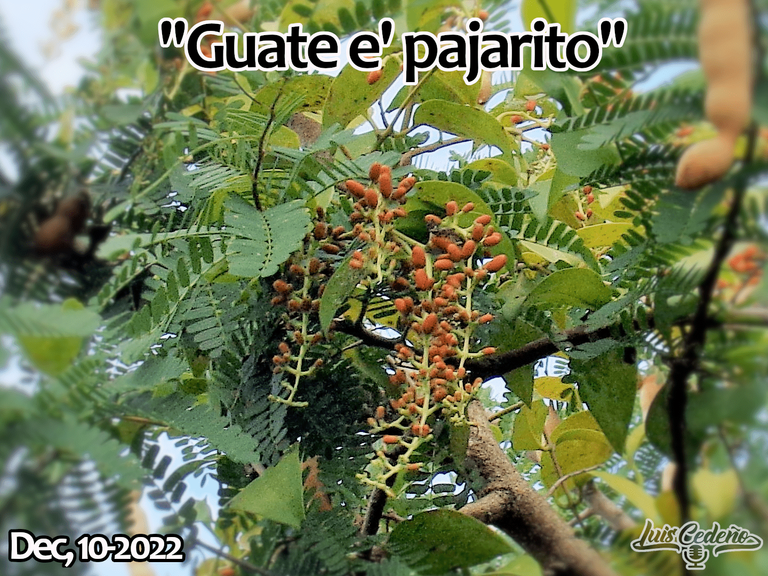

At the end of the first third of December 2022, my little nephew Daniel arrived home to look for something that his mommy had entrusted to him.
He did not want to go inside, but asked to be passed through the trellis that completes the wall that establishes the boundaries between the house's land and the rest of the private and public properties in the community.
As a restless child -while waiting- he climbs on the trellis and I watch him without saying anything, although I know the risks of doing it -I also did it at his age or earlier- and that's why I let him develop his skills. That's when he announces something that immediately worried me...
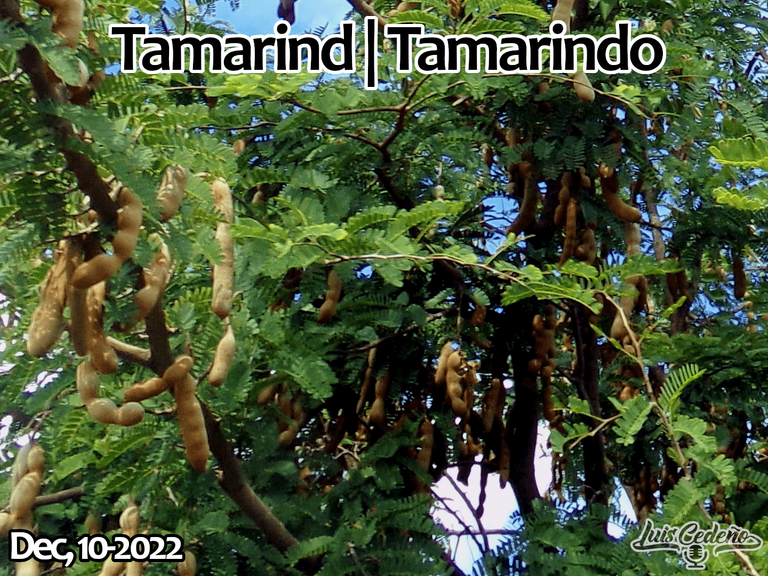
In the backyard of my house I have a tamarind about 5-6 meters high. In my experience, this plant sheds its leaves in May, leaving its branches almost bare, to later flower and develop its fruits that it will give us during the season. That season does not arrive until mid-January, and yes, by the date of this publication we are already harvesting fruits.
That tamarind was born spontaneously (i.e., unplanned); a meter and a half away from the access door to the backyard, among several papayas whose seeds were accidentally scattered in that same area. I would never have imagined that a plant whose trunk is hollow, like the papaya, would have such powerful roots; imagine that they lifted debris that once, the masons who worked on the house, left accumulated in that area. I took advantage of this to remove it.
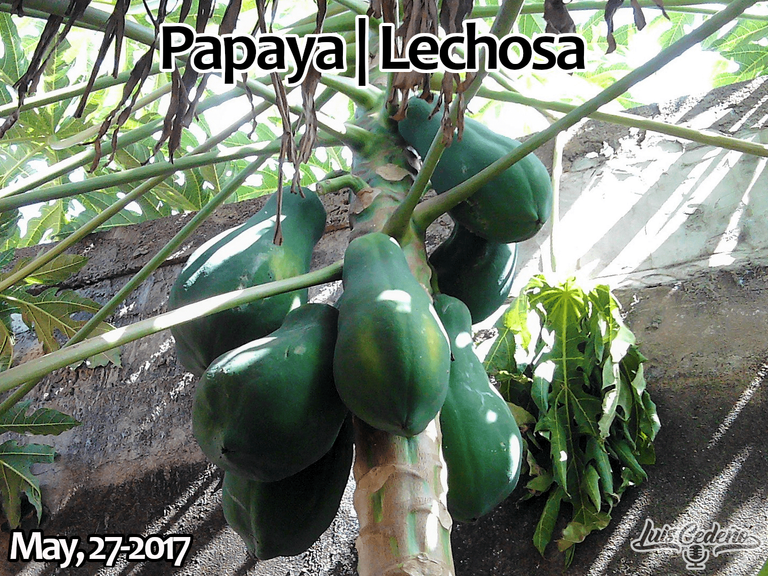
Today, there is not a papaya plant left in the yard. But I do not hesitate to plant again, if I get seeds of a fruit that captivates me....
Once, when the tamarind was a little over 2 meters tall, I cut it down, leaving only a stem no more than 12cm from the ground. Days or weeks later, I noticed its determination to grow and just be what it is. So I left it alone and today it pleases me with good loads of fruit, plus good shade during the day, which helps lower the temperature in the house.
Today, after waiting for it to grow and mature to bear fruit, it had problems and had to be helped...
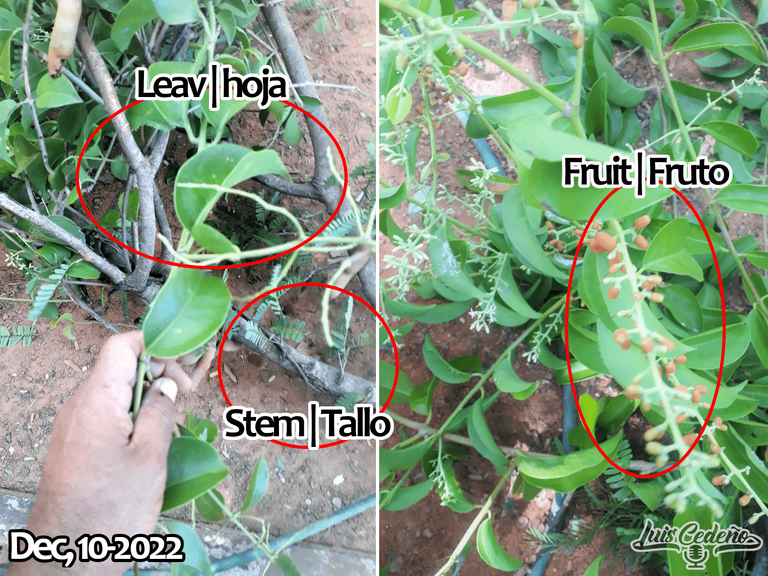
In the preceding photos, we can appreciate its leaves. Much larger than the tiny "sun swallowers" of the tamarind. While its thin stem, comes along the stem of the tamarind branch as if it were a vine. Finally, we can see its fruit, as tiny as a corn seed for popcorn. Easily swallowed by birds to travel to their next destination.
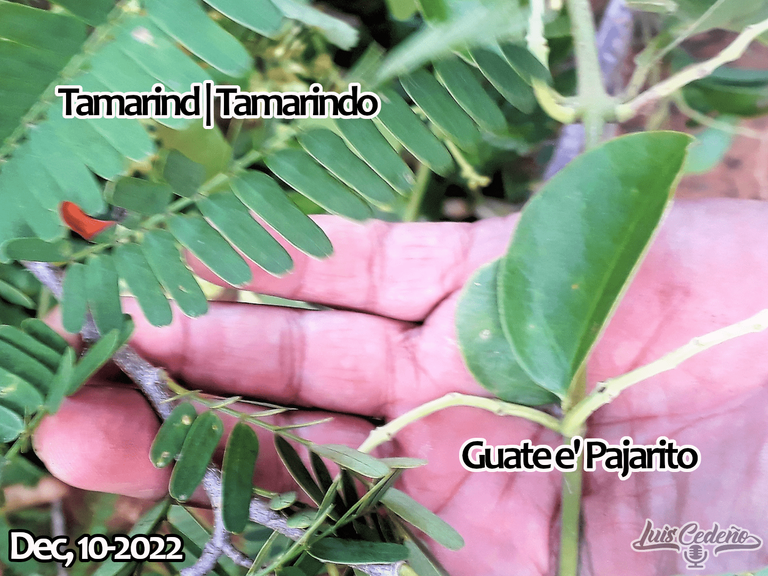
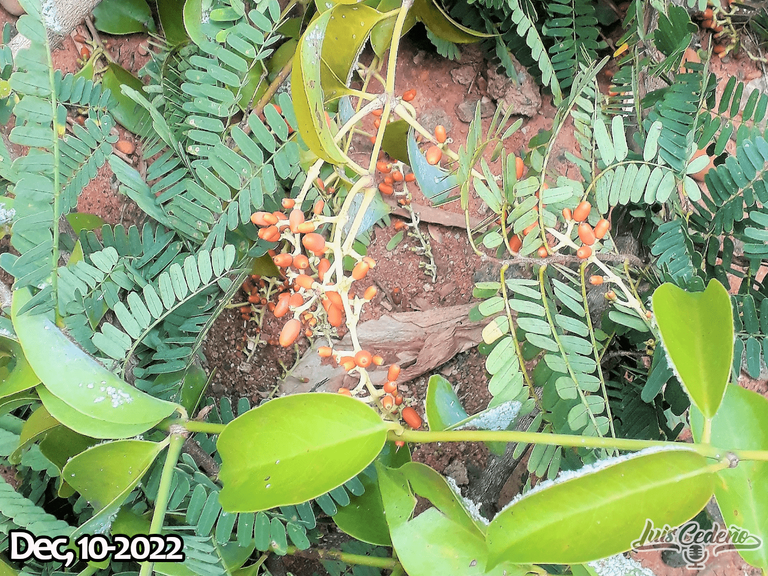
When my nephew climbed on the trellis and looked over the roof, he saw what I would never have seen from the backyard: guate e' pajarito. It is a very intelligent pest, which, with the passing of evolution, learned to preserve itself and how! It is a very invasive and aggressive parasitic plant. In my opinion, it is an involution in nature, although it fulfills its life cycle, but at the cost of the life of its host. When my nephew alerted me to this, I immediately climbed the tree with my cutlass sharpened in my hand to remove the compromised branches before it spread further and compromised the life of the tamarind.
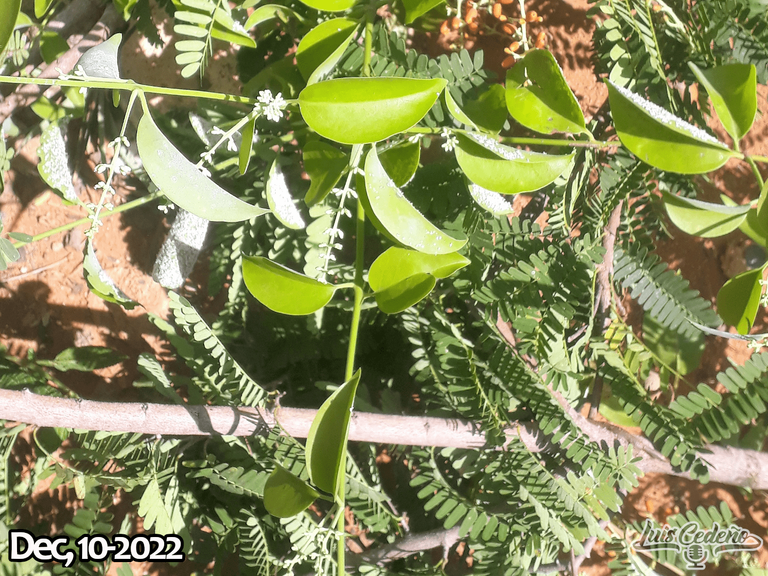
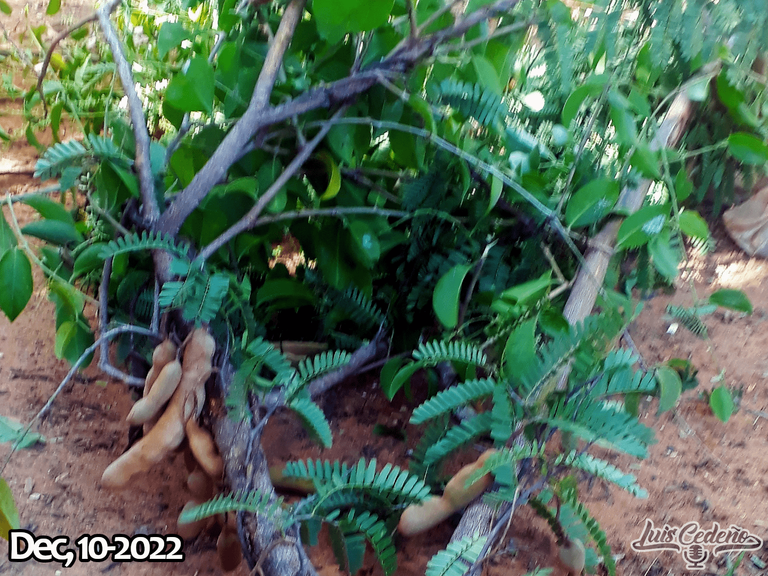
In Venezuela it is normal for it to rain in December; however, from January to the beginning of May there is dry weather with intense sunshine. Tap water will never be like rain water, but it is what there is; besides, the service has a standard rate for everyone (except the industrial and commercial sector) and it is relatively cheap, but not very well treated nowadays.) However, it is a period where you have to hydrate the plants twice a day, at least to keep them safe, until the rains come in the middle of the year.
So I made the decision to cut off the compromised branches at the very moment my nephew warned me; because this year, January has not been like in previous years and February started in a similar way. We have had rainy days alternating with sunny days, which could help a plant like *guate e' pajarito to grow quickly and tuck in the host in a short time.
They call it that way because when the birds feed on its tiny fruits, they pass through the digestive tract and their seeds pass through unharmed and are expelled by evacuation. Then when it falls on some plant, it attaches itself to the bark and immediately "drills" it and begins to extract its sap from which it feeds.
I don't know if it is called by any other name, I just know that this is what it is called. The curious thing is that this plant performs photosynthesis....
So I climbed to the top and with the help of my nephew who directed me from the roof of the house, I identified the branches to cut. There were a total of 4 branches sacrificed that same day, taking care of the life of the tamarind tree at all times. Then I cut them as small as I could and placed them in a corner of the yard, where I left them for nature to do its work and turn them into compost.
If you ask me if all that work has been worth it, well....
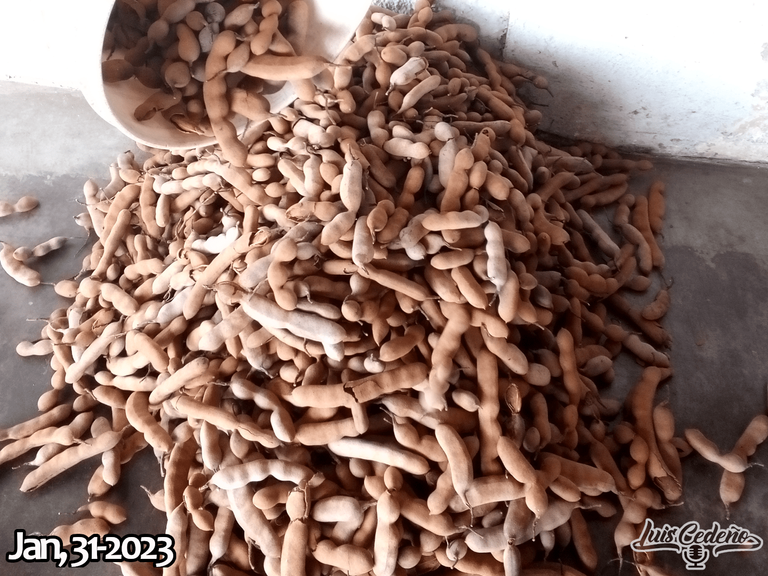
Here I share with you (a photo), part of the first harvest of this year 2023...
I hope you like it (the picture)...

**Keep up the beautiful everybody.
**Greetings and blessings.

Always alummno in all my rrss. Yes, with double "m".
Final notes:
- For the realization of this post no harm was recorded to any living being, except for those insects that may have been on the road and under my feet.
- If there is an image or video of someone else, used for demonstrative or disruptive purposes, I try to place the link that will direct them to the page of its author or owner.
- All images with my logo are mine, taken with different devices over time. If you have any concern about them, please let me know promptly to take into account your observation.
Thanks for your understanding.


Finalizando el primer tercio de diciembre de 2022, mi sobrinito Daniel llega a casa para buscar algo que le encomendó su mami.
No quiso entrar, sino que pidió que se lo pasaran por el enrejado que completa la pared que establece los linderos del terreno de la casa del resto de las bienhechurías privadas y públicas en la comunidad.
Como niño inquieto —mientras espera— se sube en el enrejado y lo observo sin decir nada pues, aunque conozco los riesgos de hacerlo —yo también lo hice a su edad o más temprano— y por eso lo dejo para que desarrolle más sus habilidades (si no se “esmamona” = cae). Es entonces cuando él me anuncia algo que de inmediato me preocupó...

En el patio de la casa tengo un tamarindo de unos 5-6 mts de altura. En mi experiencia, esta planta bota las hojas a partir de mayo, dejando casi desnudas sus ramas, para posteriormente florecer y desarrollar sus frutos que nos brindará en temporada. Esa temporada no llega, sino hasta mediados de enero. ¡Y si! Para la fecha de esta publicación ya estamos recogiendo frutos.
Ese tamarindo nació de forma espontánea (es decir, no planificada); a metro y medio de distancia de la puerta de acceso al patio, entre varias lechosas (papayas) cuyas semillas fueron esparcidas accidentalmente en esa misma área. Jamás me hubiese imaginado que una planta cuyo tronco es hueco, como la lechosa, tuviese raíces tan poderosas; imagínense que levantaron escombros que alguna vez, los albañiles que trabajaron en la casa, dejaron acumulados en esa área. Lo que aproveché para irlos retirando.

Hoy en día, no queda una planta de lechosa en el patio. Pero no dudo en volver a sembrar, si consigo semillas de un fruto que me cautive...
Una vez cuando el tamarindo ya sobrepasaba poco más de 2 metros de altura lo corté, dejando solo un tallo no mayor a 12cm desde el suelo. Días o semanas después, noté su determinación a crecer y simplemente Ser lo que es. Entonces lo dejé tranquilo y hoy me complace con buenas cargas de frutos, además de buena sombra durante el día, la cual ayuda a bajar la temperatura de la casa.
Hoy en día, luego de esperar a que creciera y madurara para dar sus frutos, tuvo problemas y hubo que socorrerla…

En la foto precedente, podemos apreciar sus hojas. Mucho más grandes que las diminutas “traga sol” del tamarindo. Mientras que su tallo finito, viene recorriendo el de la rama de tamarindo como si fuese una enredadera. Finalmente, podemos ver su fruto, tan diminuto como una semilla de maíz para cotufas o palomitas. Fáciles de tragar por las pájaros para viajar a su próximo destino.


Cuando mi sobrino se montó en el enrejado y miró por encima del techo, observó lo que yo desde el patio nunca hubiese visto: guate e' pajarito. Es una peste muy inteligente, que con el transcurrir de la evolución, aprendió a preservarse y ¡vaya de qué manera! Es una planta parásita muy invasiva y agresiva. A mi modo de ver es una involución en la naturaleza, a pesar que cumple con su ciclo vital, pero a costa de la vida de su huésped. Cuando mi sobrino me alerta al respecto, inmediatamente subí al árbol con mi afilado machete en la mano para retirar las ramas comprometidas antes que, esta se propagase aún más y comprometiera la vida del tamarindo.


En Venezuela es normal que en diciembre llueva; sin embargo, desde enero hasta principios de mayo son de clima seco con sol intenso. El agua del grifo jamás será como la de lluvia, pero es la que hay; amén de que el servicio tiene una tarifa estándar para todos (menos al sector industrial y comercial) y es relativamente barata, pero no muy bien tratada hoy día). Sin embargo, es un período donde hay que hidratar a las plantas dos veces al día, por lo menos para mantenerlas a salvo, hasta que entren las lluvias a mitad de año.
Entonces tomé la decisión de cortarle las ramas comprometidas en el mismo momento en que mi sobrino me advirtió; pues este año, enero no ha sido como en años anteriores y febrero inició de forma similar. Hemos tenido días de lluvias alternando con días de sol, lo que podía ayudar a una planta como la *guate e' pajarito a crecer rápidamente y arropar al huésped en corto tiempo.
La llaman de esa manera porque al alimentarse los pájaros de sus semillas, estas pasan por el tracto digestivo sin sufrir daño y son expulsadas mediante la evacuación. Entonces al salir expulsada sobre alguna planta, se adhiere a la corteza e inmediatamente la “taladra” y comienza a extraer su savia de la cual se alimenta.
No sé si la llaman de otra manera, solo sé que así le dicen. Lo curioso es que esta planta realiza fotosíntesis…
Así que al subir a lo alto y con la ayuda de mi sobrino que desde el techo de la casa me dirigía, fui identificando las ramas a cortar. Fueron en total 4 ramas que se sacrificaron ese mismo día, procurando la vida del tamarindo en todo momento. Luego las corté lo más pequeña que pude y las dispuse en un rincón del patio, donde las dejé para que la naturaleza haga su obra y convertirla en abono.
Si me preguntan si todo ese trabajo ha valido la pena, Pues…

Acá les comparto (una foto) parte de primera cosecha de este año 2023...
Espero les guste (la imagen).

Sigan hermosamente guapetones.
Saludos y bendiciones.

Siempre alummno en todas mis rrss. Si, con doble "m".
Notas finales:
- Para la realización de este post no se registró daño a ningún ser vivo, salvo a aquellos insectos que pudieron estar en el camino y bajo mis pies.
- Si hay una imagen o vídeos ajeno, empleado con fines demostrativos o disruptivos, procuro colocar el link que los dirigirá hacia la página de su autor o propietario.
- Todas las imágenes con mi logo, son mías, tomadas con distintos dispositivos en el transcurrir del tiempo. Si tiene alguna inquietud respecto a las mismas, por favor comuníquemelo prontamente para tomar en cuenta su observación.
Gracias por comprender.
Excelente post mi Luis y esos frutos que nos regala Dios son muestra de lo maravillosa que es su obra, saludos
Esta foto de Tamarindo me hizo agua la boca jejeje
Excellent post my Luis and those fruits that God gives us are a sign of how wonderful his work is, greetings.
This photo of Tamarindo made my mouth water hehehehe
Hola mi linda y amada @leslieq78.
Deseo estés excelente.
Gracias por leer.
Pues fíjate que los que tienen mas tiempo, están dulces y son los de concha (cáscara) mas oscura. Pero hay un problema.. La lluvia...
Esta lluvia los pone como cremosos y toda la pulpa se adhiere facilmente a la concha.
Entonces estoy dejándolos un tiempo en reserva a ver si deshidratan un poco...
Por otro lado... Anteayer corté mi primer racimo de cambur (banana) manzano de este año.
Hello my beautiful and beloved @leslieq78,
I wish you are excellent, thank you for reading.
Well, notice that the ones that have more time, are sweet and are the ones with darker shells. But there is a problem: The rain...
This rain makes them creamy and all the pulp sticks easily to the shell.
So I'm leaving them in reserve for a while to see if they dehydrate a little...
On the other hand... The day before yesterday I cut my first bunch of apple bananas this year.
Still beautiful... Kisses
Que buenos recuerdos me ha traido tu Post, @alummno
En mi niñez en México disfrutaba mucho de comer el Tamarindo. Casi lo puedo saborear ahora mismo.
!PAL
Oh... que bueno...
Y eso que no puse elementos visuales que evocaran otras épocas, como en el anterior. jejejeje
Saludos y bendiciones.
Gracias por pasar a leer
i Love tamarind 🤩
There are two of us, brother...